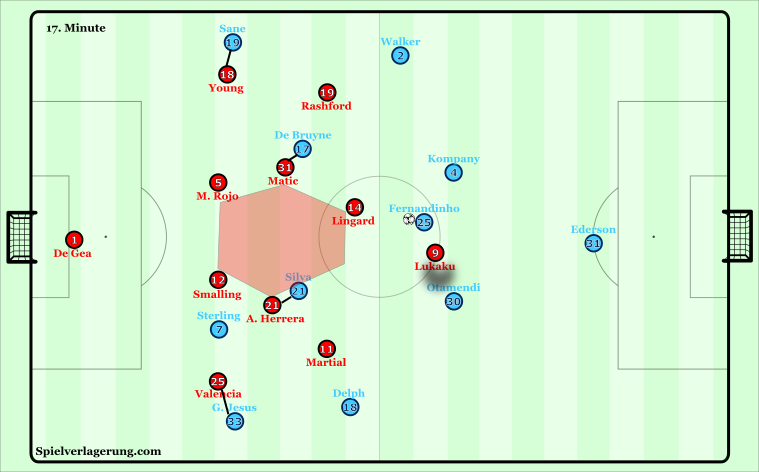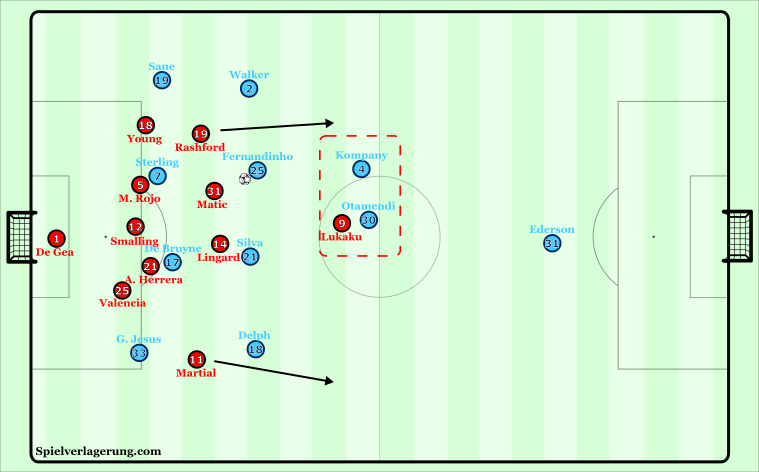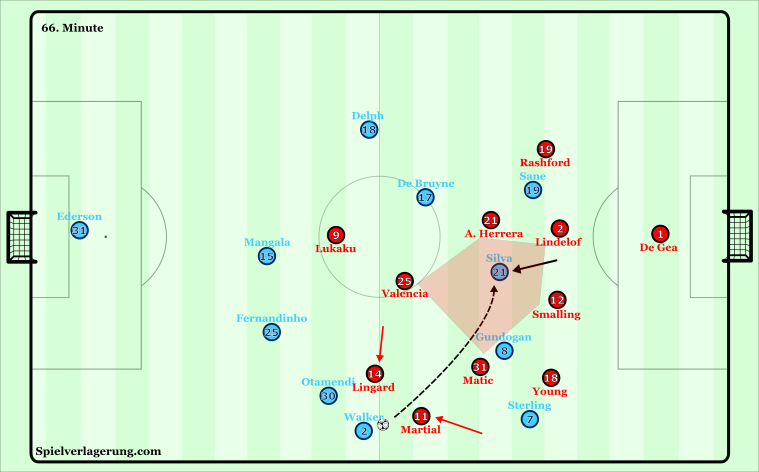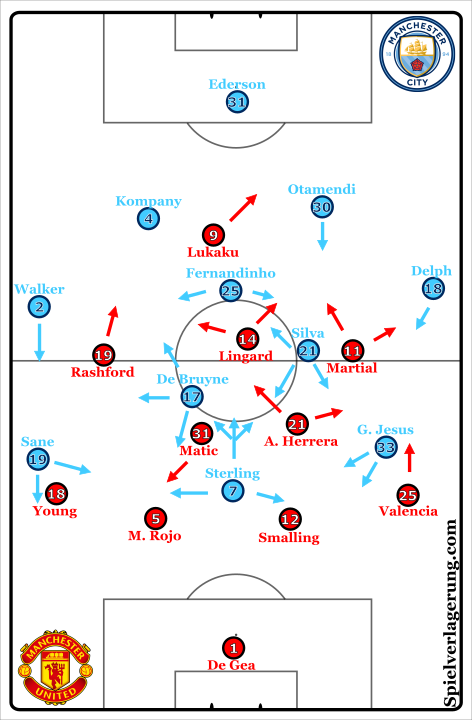Manchester City prevail at Old Trafford
Manchester is Blue. Pep Guardiola’s team continue their quest to the Premier League title with a key win in the 175th playing of the Manchester Derby. After the match, City extend their unbeaten streak to 16 games, drawing only once in the league in that time and setting a new record of winning 14 consecutive matches. City also have an 11 point gap over their crosstown rivals. Manchester United remain in second place, but this result makes their quest for the league title a difficult task.
The largest talking point going into the match was who wasn’t going to be playing, specifically Paul Pogba. The exuberant midfielder out of this match due to suspension, receiving a straight red card during United’s away win at Arsenal. To replace the Frenchman, Ander Herrera was slotted next to Nemanja Matic. Jose Mourinho opted to change his team’s formation back to a 4-2-3-1, as seen in numerous teams he has managed over the years. Ashley Young was put in at left back following his performances over the past few weeks as a wingback in United’s 3-4-1-2 formation, while Martial and Rashford flanked Jesse Lingard to form the trio of attacking midfielders.
Manchester City were afforded the luxury of being able to rest their key players in the midweek Champions League game, so their starting selection was as expected, with perhaps the exception of Gabriel Jesus getting the nod over a recuperating Sergio Aguero.
Mourinho’s Matchplan
Rashford and Martial dropped into the midfield line when defending to form a 4-4-1-1 shape, with Lingard responsible for covering the space that Fernandinho occupied. Lingard would periodically step up in line with Lukaku, creating a 4-4-2, and these moments would take place when City were building up along the halfway line. United were reluctant to apply pressure in these instances, preferring to cover the options that could be played to and applying man-orientations to the dangerous player.
Mourinho set his team to have Silva and De Bruyne to be essentially man-marked by Herrera and Matic respectively, while Romelu Lukaku aimed to prevent the ball from going toward City’s left side by using his cover shadow to block Otamendi from receiving the ball. Otamendi would solve this later in the match by stepping up into the midfield when Kompany received the ball so he could carry it out of defense and move up the field easily, as United defenders did not want to leave their man to pressure the Argentine on the ball.
Once Kompany received the ball, United’s would pressure slightly more, with the likely intention of rushing Kompany to make a decision on the ball and having him force passes into avenues where United could win the ball. If they won the ball, they could counter through the pace and individual abilities of Rashford, Lukaku, and Martial, with Lingard acting as a central running option to switch the ball from one side to the other if the far side was open.

United’s Defensive Strategy, showing man-orientations, Lukaku’s cover shadow, and the vacated space centrally due to the man-orientations.
For those familiar with Mourinho’s work, this is hardly a surprising approach for his United team. However, due to City’s positional structure and the manner in which United defended, they struggled to generate attacks that weren’t predicated on individual skillful dribbling.
United’s Shortcomings
The aspects of Manchester City’s play in possession will be discussed in the next section, but through the way that United set out to defend City, large spaces were found centrally at various moments in the match. For example, just like the graphic above, it was common to find large spaces centrally because of Herrera and Matic being so preoccupied with the player they were marking. This allows for easier passes for any players moving into that space. Another outcome that was common to see was for a City player to take the ball and dribble up the middle, with no pressure being applied until he was close to United’s penalty area.
Due to the reluctance of United to apply pressure onto the visiting club, Man City could easily establish themselves inside the opponent’s half, while the home side would drop off and focus on defending the central areas in the penalty area. United’s crowded box defending made it so City struggled to finish off decent moves that were often generated in wider positions from Sane and Jesus. But the manner in which United defended for large portions of the match made it challenging for United to effectively counter.
When Manchester United had possession after a failed City attack, all of their players were so close together that they were easy to counterpress, as many options could be eliminated just by providing a decent cover shadow. To alleviate the pressure then, many long balls were directed towards Lukaku, and the Belgian was helpless because his support that would be behind him normally in any counter attack was too far away to link up productively. This led to City regaining possession, and the cycle would continue once again.

Due to the deep nature of United’s defending, Rashford and Martial had long distances to make up in order to provide Lukaku, outnumbered here, with any options
There is a quote from Juanma Lillo, in which he states “The quicker the ball goes forward, the quicker it comes back“. This is essentially how the match played out from United’s point of view. Manchester United were very direct in how they moved up the field, as if it wasn’t a long ball aimed for Lukaku, it was a through ball from the midfielders, or a marauding dribbling sequence taking advantage of the advanced positions of City’s fullbacks.
Sometimes these attacks work, as seen with Marcus Rashford’s goal on the stroke of halftime, but relying on them against a team intelligently positioned when your team is so deep is not optimal. When the wingers and midfielders move up to be part of the attack, they have to travel large distances to participate in the attack. As the ball moves faster than the players, the rate at which they support is usually too slow to keep up with the play if they are excessively deep. When the opposition win the ball, there exists a large gap in between the lines of players because of the movements that take place during attacking transitions. This leads to the opponent easily progressing up the field back to where United were fighting tooth and nail to protect.
Such was the nature of Manchester United’s counterattacking on the day, as they were heavily reliant on the talents of their attacking players rather than a cohesive counterattacking strategy aimed at a particular zone of the pitch. United were in a pendulum between attacking and defending, with City moving up the field quickly when the attacking 4 players moved up to attack while the rest of the team failed to move up sufficiently in anticipation of the next City attack. Later on in the match, Lingard, Martial, and Rashford became restless and tried to initate a higher press of their own, but City were able to navigate this easily.
This was due to how United’s back 4 and defensive midfielders were focused on covering rather than pressuring, and this discontinuity between the front and back of the team led to large gaps for City to play into. Overall, a better approach I feel would’ve been to force City to play long balls by implementing a higher offside line and pressure in a similar manner to how United operated against Arsenal in the prior week. The absence of Paul Pogba was a big loss, but strategically, Mourinho gave Guardiola spaces for his side to establish their superiority over the Red Devils.
City vs. United’s Defense, Adjustments to beat Man-Orientations
For Manchester City, they employed a slight variation of what has been used in the past few weeks. Rather than having Gabriel Jesus central, he was slotted out left and Raheem Sterling was placed centrally, playing as a False 9 and checking deeper into midfield to create 4v3 situations with De Bruyne, Silva, and Fernandinho. Sane was positioned on the right flank on the touchline, occasionally looking to run in behind and get on the end of long passes from the back, but these were sparse and he mainly sought to challenge Young on the dribble.
The best attacks in the opening stages of the match came from switches over to Sane, and he would frequently look to cut the ball for any runners to finish. These were anticipated and dealt with by United, meaning not many quality shots arose from these.
In an effort to gain more of the ball, Silva and De Bruyne began to drop back closer to Fernandinho. This did escape them from their marks, but offered little solution to actually breaking down United. What it did accomplish was keeping possession and have United chase to cover their spaces, leading to eventual zones that City tried to beat by combination play.
Sterling’s movement as a False 9 then acted as the main solve up the field, since Rojo and Smalling did not follow him into the deeper spots. De Bruyne and Silva were too far however to be effective options for Sterling once he got the ball, which led to many stagnant City attacks that had a lot of side to side circulation once they were high up the field.
The most amount of success for City took place when the ball went from the central areas to wide spots, as the large gaps mentioned earlier in the piece allowed them to get near the penalty area with relative ease. De Bruyne would drift righward in support of Sane, with Silva just behind him often. This made the game quite small sided and on occasion played into United’s hands. Mourinho’s team was heavily protective of the center however meaning that either shots were blocked, passed out wide and easily saved by De Gea, or cutbacks were cleared away.

One example where the movement of the false 9 was used to play forward by City. United’s front players are overzealous in the pressing, creating a gap centrally where Silva is found by Walker.
Ilkay Gundogan was brought in at halftime for Kompany, moving Fernandinho to center back for about 15 minutes, before Mangala replaced Gabriel Jesus. These shifts led to Silva playing as the false 9, Sane back to the left, and Sterling to the right. The same patterns and themes took place in this timeframe, but as United began to pressure haphazardly, Gundogan was a great asset in circulation leading to several chances for City, but were unable to convert any of these.
A Tangent on Deep Defending
Jose Mourinho said the following quote to the media after the match.
“They scored two goals which were quite unbelievable to concede. They scored two goals out of nothing with rebounds….two easy goals. We did good things, we did bad things… I think they are a very good team, they are lucky, they have decisions in their favour.”
Pep Guardiola commented about how his team had not worked on attacking set pieces all week and managed to score two of them during the match to come away with three points. While set piece goals may be a byproduct of luck, the goals themselves came from long spells of defending deep. The first corner kick goal originated from a sequence which ended in a save from Leroy Sane’s shot on target, while the second was a freekick that unfortunately deflected off a United player during a clearance into the path of Otamendi.
Perhaps Manchester City are lucky in that Ederson had a couple of world class saves 5 minutes from the injury time. However, for the sake of a thought experiment, if the events that take place in a football match are random, but somewhat determined by the positioning of players in your team, then by being close to your own goal for such a large portion of the match, you are subjecting your team to a higher risk of having one of these random events leading to a goal.
With Manchester City being so far from their goal for a majority of the game, they are subjecting themselves to less risk of conceding because United have a large distance to travel in order to score. Therefore, Mourinho’s tactics of sitting deep and hitting on the counter do not in fact provide the best chance of winning big matches against opponents of equal or superior skill. While it does work sometimes, it is pretty risky and very dependent on having certain “random” events, like set pieces, go in your favor (in terms of not conceding, or scoring them) for 90 minutes. Football doesn’t always work like that, and managers should have tactics that don’t depend so much on chance.
This may be expanded on the future in a tactical theory piece in the future, but for now, it should be stated that defending deep is not the most risk averse strategy a manager can employ. As we saw with PSG-Barcelona earlier this year or even BVB against Schalke, this instinct of protecting your own goal at all costs is counter productive and just increases the amount of opposition attacks and places constant pressure on your defense.
Conclusion
While this wasn’t the spectacle of previous Manchester Derbies or prior encounters between Jose and Pep, the loss will sting from United’s point of view, as Manchester City inevitably look like they will march to the title. In a less than top performance, City still demonstrated their quality over their neighbors. Even though both teams have about equal squads in terms of ability, Manchester City were better on the day, and saying Guardiola has nothing to do with that is naive. His way is working in England after all.



3 Kommentare Alle anzeigen
amateur October 14, 2019 um 8:18 pm
The below image shows you what a more narrow positioning of Martial could give United on Sunday. As Pogba has just received the ball, Martial sets off on the left. Look at the advantage his starting position gives him over Bournemouth s right-back Simon Francis. Not only is Martial quicker, he also starts five meters further forward. This makes United really dangerous on the break as Martial can instantly combine with Sanchez or Pogba on the break. With City likely to double up in wide areas with both the winger and the full-back, Martial are likely to defend as a left-back in a United shape that will more resemble a 6-3-1 and negate any counter-attacking threat they wish to pose. Mourinho should really consider using Martial more narrow as it was one of the reasons behind their improved performance on Saturday.
Mbuguz_ December 15, 2017 um 2:30 pm
The time wasting tactic in the 89th minute courtesy of Raheem,KDB and Bernardo Silva was a classic
odaimoko December 14, 2017 um 2:44 am
it seems that man utd don’t know what to do when they are in attack phase(in possession when city’s defense is complete), so i dont think high pressure and a offside tactic is a good idea.